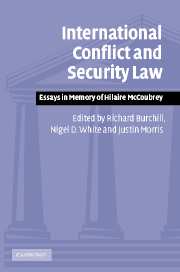Book contents
- Frontmatter
- Contents
- Biography of Hilaire McCoubrey
- Notes on contributors
- Foreword: There are men too gentle to live among wolves
- List of abbreviations
- 1 Hilaire McCoubrey and international conflict and security law
- 2 The development of operational law within Army Legal Services
- 3 Reflections on the relationship between the duty to educate in humanitarian law and the absence of a defence of mistake of law in the Rome Statute of the International Criminal Court
- 4 Superior orders and the International Criminal Court
- 5 Command responsibility: victors' justice or just desserts?
- 6 The proposed new neutral protective emblem: a long-term solution to a long-standing problem
- 7 Towards the unification of international humanitarian law?
- 8 Of vanishing points and paradoxes: terrorism and international humanitarian law
- 9 What is a legitimate military target?
- 10 The application of the European Convention on Human Rights during an international armed conflict
- 11 Regional organizations and the promotion and protection of democracy as a contribution to international peace and security
- 12 Self-defence, Security Council authority and Iraq
- 13 International law and the suppression of maritime violence
- 14 Law, power and force in an unbalanced world
- Bibliography of Hilaire McCoubrey's work
- Index
12 - Self-defence, Security Council authority and Iraq
Published online by Cambridge University Press: 17 July 2009
- Frontmatter
- Contents
- Biography of Hilaire McCoubrey
- Notes on contributors
- Foreword: There are men too gentle to live among wolves
- List of abbreviations
- 1 Hilaire McCoubrey and international conflict and security law
- 2 The development of operational law within Army Legal Services
- 3 Reflections on the relationship between the duty to educate in humanitarian law and the absence of a defence of mistake of law in the Rome Statute of the International Criminal Court
- 4 Superior orders and the International Criminal Court
- 5 Command responsibility: victors' justice or just desserts?
- 6 The proposed new neutral protective emblem: a long-term solution to a long-standing problem
- 7 Towards the unification of international humanitarian law?
- 8 Of vanishing points and paradoxes: terrorism and international humanitarian law
- 9 What is a legitimate military target?
- 10 The application of the European Convention on Human Rights during an international armed conflict
- 11 Regional organizations and the promotion and protection of democracy as a contribution to international peace and security
- 12 Self-defence, Security Council authority and Iraq
- 13 International law and the suppression of maritime violence
- 14 Law, power and force in an unbalanced world
- Bibliography of Hilaire McCoubrey's work
- Index
Summary
Introduction
It is not possible to understand the threat and then the use of force against Iraq by the USA and the United Kingdom in 2003 without understanding the developments that have occurred in state practice since the Gulf Conflict of 1991. In the period after 1993, the USA and the United Kingdom, sometimes with other states, have placed incredible pressure on the legal framework governing the use of force contained in the UN Charter in a concerted effort to widen both exceptions to the ban on the threat or use of force in Article 2(4), namely the right of self-defence contained in Article 51, and military action taken under the authority of the Security Council derived from Article 42. While in 1991, Operation Desert Storm conducted by the Coalition of states against Iraq, under American command, but with UN Security Council authority, was generally viewed as lawful (by Hilaire and myself amongst many others), the military action taken against Iraq commencing on 20 March 2003 was much more controversial. After the adoption of Resolution 1441 on 8 November 2002, the USA and the United Kingdom brought the above-mentioned pressures to bear by making claims that the resolution was by itself sufficient to justify the use of force against Iraq, even though it did not contain clear authorizing language.
- Type
- Chapter
- Information
- International Conflict and Security LawEssays in Memory of Hilaire McCoubrey, pp. 235 - 264Publisher: Cambridge University PressPrint publication year: 2005

